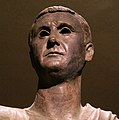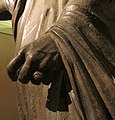This is an old revision of this page, as edited by Carlotm (talk | contribs) at 04:59, 24 May 2015 (Moved content from "Aule Metele" page). The present address (URL) is a permanent link to this revision, which may differ significantly from the current revision.
Revision as of 04:59, 24 May 2015 by Carlotm (talk | contribs) (Moved content from "Aule Metele" page)(diff) ← Previous revision | Latest revision (diff) | Newer revision → (diff)| This article does not cite any sources. Please help improve this article by adding citations to reliable sources. Unsourced material may be challenged and removed. Find sources: "The Orator" – news · newspapers · books · scholar · JSTOR (September 2012) (Learn how and when to remove this message) |
| The Orator | |
|---|---|
 | |
| Year | c. 100 BCE |
| Medium | bronze |
| Dimensions | 179 cm (70 in) |
| Location | National Archaeological Museum, Florence |
Aule Metele, Latin: Aulus Metellus; also known as The Orator, Italian: L'Arringatore, is a bronze sculpture 179 cm high. It is a Romano-Etruscan work from the late second century or early first century BCE in the Roman style and depicts an Etruscan man, Aule Metele, wearing a short Roman toga and footwear. His right arm is raised to indicate that he is an orator addressing the public.
The retrograde inscription is in the Etruscan alphabet reads: : “auleśi meteliś ve vesial clenśi / cen flereś tece sanśl tenine / tu θineś χisvlicś” (“To (or from) Auli Meteli, the son of Vel and Vesi, Tenine (?) set up this statue as a votive offering to Sans, by deliberation of the people”).
References
- Larissa Bonfante (1986). Etruscan Life and Afterlife: A Handbook of Etruscan Studies. Wayne State University Press. pp. 139–. ISBN 0-8143-1813-4.
- Horst Woldemar Janson; Anthony F. Janson (2004). History of Art: The Western Tradition. Prentice Hall Professional. pp. 190–. ISBN 978-0-13-182895-7.
- TLE 651; CIE 4196
- Koen Wylin (2000). Il verbo etrusco: ricerca morfosintattica delle forme usate in funzione verbale. L'ERMA di BRETSCHNEIDER. pp. 112–. ISBN 978-88-8265-084-1.
This sculpture article is a stub. You can help Misplaced Pages by expanding it. |



